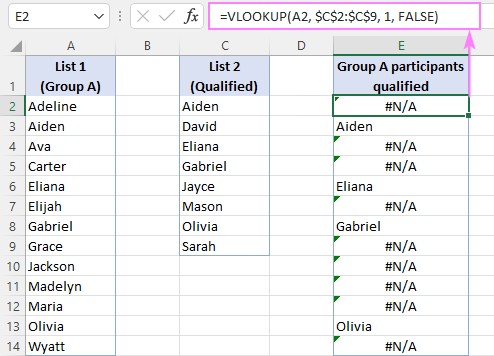VLOOKUP in Excel is a powerful function to compare two columns and find matches or differences. At COMPARE.EDU.VN, we provide comprehensive guides on using Excel functions to streamline your data analysis. This article will show you how to master VLOOKUP for efficient data comparison, empowering you to make informed decisions based on your data with related keywords such as excel lookup and compare data.
Table of Contents
- Understanding the Basics of VLOOKUP
- How to Compare Two Columns in Excel Using VLOOKUP
- Disguising #N/A Errors for Cleaner Results
- Comparing Two Columns in Different Excel Sheets
- Compare Two Columns and Return Common Values (Matches)
- Compare Two Columns and Find Missing Values (Differences)
- VLOOKUP Formula to Identify Matches and Differences
- Compare Two Columns and Return a Value from Third
- Alternative Comparison Tools
- FAQ: Mastering VLOOKUP for Column Comparison
1. Understanding the Basics of VLOOKUP
VLOOKUP, which stands for Vertical Lookup, is an Excel function that searches for a value in the first column of a range and returns a value from another column in the same row. It’s essential for data analysis, reporting, and comparing datasets. Understanding its components is the first step in mastering its use. VLOOKUP allows users to efficiently extract relevant information from large datasets by matching a specific value (lookup_value) against a range of data (table_array). The function then returns a corresponding value from a specified column (col_index_num) within that range. By specifying whether to look for an exact or approximate match (range_lookup), users can fine-tune the search to retrieve the most accurate results.
The syntax of the VLOOKUP function is as follows:
=VLOOKUP(lookup_value, table_array, col_index_num, [range_lookup])
- lookup_value: The value you want to search for.
- table_array: The range of cells where you want to search. The lookup value must be in the first column of this range.
- col_index_num: The column number in the table_array from which to return a value.
- range_lookup: An optional argument that specifies whether to find an exact match (FALSE) or an approximate match (TRUE). If omitted, it defaults to TRUE.
2. How to Compare Two Columns in Excel Using VLOOKUP
VLOOKUP can be used to compare two columns of data and identify common values. This is particularly useful when you have two lists and want to determine which items from one list also appear in the other.
Here’s how to do it:
-
Set up your data: Ensure your two columns of data are in adjacent columns. Let’s say List 1 is in column A and List 2 is in column C.
-
Enter the VLOOKUP formula: In a new column (e.g., column E), enter the following formula in the first cell (E2):
=VLOOKUP(A2, $C$2:$C$9, 1, FALSE)A2is the first value in List 1 that you want to search for in List 2.$C$2:$C$9is the range of cells containing List 2. The dollar signs ($) create absolute references, ensuring the range doesn’t change when you copy the formula down.1specifies that you want to return the value from the first column of the table_array (List 2).FALSEspecifies that you want an exact match.
-
Copy the formula down: Drag the fill handle (the small square at the bottom-right of the cell) down to apply the formula to all the cells in List 1.
The formula will return the matching values from List 2 for items that are present in both lists. For items that are not in List 2, it will return a #N/A error.
3. Disguising #N/A Errors for Cleaner Results
The #N/A errors returned by VLOOKUP can be distracting. To replace these errors with more user-friendly results, you can use the IFNA or IFERROR functions.
Using IFNA
The IFNA function allows you to specify a value to return if the VLOOKUP formula results in a #N/A error.
-
Modify the VLOOKUP formula: Wrap the VLOOKUP formula with the IFNA function:
=IFNA(VLOOKUP(A2, $C$2:$C$9, 1, FALSE), "")This formula will return an empty string (“”) instead of #N/A, resulting in a blank cell.
-
Copy the formula down: Drag the fill handle down to apply the formula to all the cells in List 1.
You can also replace the empty string with custom text, such as “Not Found” or “Not in List 2”:
=IFNA(VLOOKUP(A2, $C$2:$C$9, 1, FALSE), "Not in List 2")
Using IFERROR
The IFERROR function is similar to IFNA but can handle all types of errors, not just #N/A.
-
Modify the VLOOKUP formula: Wrap the VLOOKUP formula with the IFERROR function:
=IFERROR(VLOOKUP(A2, $C$2:$C$9, 1, FALSE), "")This formula will also return an empty string (“”) instead of #N/A or any other error.
-
Copy the formula down: Drag the fill handle down to apply the formula to all the cells in List 1.
4. Comparing Two Columns in Different Excel Sheets
Often, the columns you need to compare are not on the same sheet. VLOOKUP can easily handle this by using external references.
-
Set up your data: Ensure your two lists are in different sheets within the same Excel workbook. For example, List 1 is in column A of Sheet1, and List 2 is in column A of Sheet2.
-
Enter the VLOOKUP formula: In Sheet1, enter the following formula in cell B2:
=IFNA(VLOOKUP(A2, Sheet2!$A$2:$A$9, 1, FALSE), "")A2is the first value in List 1 on Sheet1.Sheet2!$A$2:$A$9is the range of cells containing List 2 on Sheet2.1specifies that you want to return the value from the first column of the table_array (List 2).FALSEspecifies that you want an exact match.
-
Copy the formula down: Drag the fill handle down to apply the formula to all the cells in List 1 on Sheet1.
This formula compares the values in Sheet1 with the values in Sheet2 and returns matches or blanks, just like in the previous examples.
5. Compare Two Columns and Return Common Values (Matches)
To get a list of common values without gaps, you can use the FILTER function (available in Excel 365 and Excel 2021) in combination with VLOOKUP.
-
Enter the FILTER formula: In a new column (e.g., column F), enter the following formula:
=FILTER(A2:A14, IFNA(VLOOKUP(A2:A14, C2:C9, 1, FALSE), "")<>"")A2:A14is the range of cells containing List 1.C2:C9is the range of cells containing List 2.IFNA(VLOOKUP(A2:A14, C2:C9, 1, FALSE), "")<>""is the criteria that filters out blank cells, returning only common values.
Alternatively, you can use the ISNA function to check the result of VLOOKUP and filter the items evaluating to FALSE:
=FILTER(A2:A14, ISNA(VLOOKUP(A2:A14, C2:C9, 1, FALSE))=FALSE)
With XLOOKUP:
=FILTER(A2:A14, XLOOKUP(A2:A14, C2:C9, C2:C9,"")<>"")
This formula dynamically returns a list of common values without any gaps.
6. Compare Two Columns and Find Missing Values (Differences)
To compare two columns and find the values that are in List 1 but not in List 2, you can use the IF and ISNA functions together with VLOOKUP.
-
Enter the formula: In a new column (e.g., column F), enter the following formula in the first cell (F2):
=IF(ISNA(VLOOKUP(A2, $C$2:$C$9, 1, FALSE)), A2, "")A2is the first value in List 1.$C$2:$C$9is the range of cells containing List 2.ISNA(VLOOKUP(A2, $C$2:$C$9, 1, FALSE))checks if the VLOOKUP returns a #N/A error.- If the VLOOKUP returns #N/A, the formula returns the value from List 1 (A2); otherwise, it returns an empty string (“”).
-
Copy the formula down: Drag the fill handle down to apply the formula to all the cells in List 1.
To dynamically filter the list of missing values, use the FILTER function in Excel 365 and Excel 2021:
=FILTER(A2:A14, ISNA(VLOOKUP(A2:A14, C2:C9, 1, FALSE)))
Or using XLOOKUP:
=FILTER(A2:A14, XLOOKUP(A2:A14, C2:C9, C2:C9,"")="")
7. VLOOKUP Formula to Identify Matches and Differences
To add text labels to the first list indicating which values are available in the second list and which are not, combine VLOOKUP with the IF and ISNA/ISERROR functions.
-
Enter the formula: In a column adjacent to List 1 (e.g., column E), enter the following formula in cell E2:
=IF(ISNA(VLOOKUP(A2, $D$2:$D$9, 1, FALSE)), "Not Qualified", "Qualified")A2is the first value in List 1.$D$2:$D$9is the range of cells containing List 2.ISNA(VLOOKUP(A2, $D$2:$D$9, 1, FALSE))checks if the VLOOKUP returns a #N/A error.- If the VLOOKUP returns #N/A, the formula returns “Not Qualified”; otherwise, it returns “Qualified”.
-
Copy the formula down: Drag the fill handle down to apply the formula to all the cells in List 1.
Another way to identify matches and differences is using the MATCH function:
=IF(ISNA(MATCH(A2, $D$2:$D$9, 0)), "Not in List 2", "In List 2")
8. Compare Two Columns and Return a Value from Third
When you need to compare names in two columns and return a corresponding value from a third column, VLOOKUP is the perfect tool.
-
Set up your data: Ensure you have two tables with related data. For example, Table 1 has names in column A, and Table 2 has names in column D and corresponding times in column E.
-
Enter the formula: In a new column in Table 1 (e.g., column B), enter the following formula in cell B3:
=VLOOKUP(A3, $D$3:$E$10, 2, FALSE)A3is the first name in Table 1.$D$3:$E$10is the range of cells in Table 2 containing the names and times.2specifies that you want to return the value from the second column of the table_array (the time).
-
Copy the formula down: Drag the fill handle down to apply the formula to all the names in Table 1.
To handle #N/A errors, use the IFNA function:
=IFNA(VLOOKUP(A3, $D$3:$E$10, 2, FALSE), "Not Available")
Alternative methods include using INDEX MATCH or XLOOKUP:
=IFNA(INDEX($E$3:$E$10, MATCH(A3, $D$3:$D$10, 0)), "")
=XLOOKUP(A3, $D$3:$D$10, $E$3:$E$10, "")
9. Alternative Comparison Tools
While VLOOKUP is powerful, other tools can streamline data comparison tasks, especially for frequent users:
- Compare Tables: Quickly finds duplicates and unique values in two datasets.
- Compare Two Sheets: Highlights differences between two worksheets.
- Compare Multiple Sheets: Finds and highlights differences in multiple sheets at once.
These tools provide more efficient and user-friendly alternatives for complex comparison tasks.
10. FAQ: Mastering VLOOKUP for Column Comparison
Q1: What is VLOOKUP, and how does it work in Excel?
A1: VLOOKUP (Vertical Lookup) is an Excel function that searches for a value in the first column of a range and returns a value from another column in the same row. It’s used for data analysis, reporting, and comparing datasets.
Q2: How do I compare two columns in Excel using VLOOKUP?
A2: Use the formula =VLOOKUP(A2, $C$2:$C$9, 1, FALSE) where A2 is the first value in List 1, and $C$2:$C$9 is the range of cells containing List 2. This will return matching values from List 2 for items present in both lists.
Q3: How can I hide or replace #N/A errors when using VLOOKUP?
A3: Use the IFNA or IFERROR functions to replace #N/A errors. For example, =IFNA(VLOOKUP(A2, $C$2:$C$9, 1, FALSE), "") will return an empty string instead of #N/A.
Q4: Can I compare two columns in different Excel sheets using VLOOKUP?
A4: Yes, use external references. For example, =IFNA(VLOOKUP(A2, Sheet2!$A$2:$A$9, 1, FALSE), "") compares values in Sheet1 with values in Sheet2.
Q5: How do I return common values (matches) between two columns using VLOOKUP?
A5: Use the FILTER function in combination with VLOOKUP: =FILTER(A2:A14, IFNA(VLOOKUP(A2:A14, C2:C9, 1, FALSE), "")<>""). This dynamically returns a list of common values without gaps.
Q6: How can I find missing values (differences) between two columns using VLOOKUP?
A6: Use the IF and ISNA functions together with VLOOKUP: =IF(ISNA(VLOOKUP(A2, $C$2:$C$9, 1, FALSE)), A2, "").
Q7: How do I identify matches and differences between two columns with text labels using VLOOKUP?
A7: Combine VLOOKUP with the IF and ISNA functions: =IF(ISNA(VLOOKUP(A2, $D$2:$D$9, 1, FALSE)), "Not Qualified", "Qualified").
Q8: How do I compare two columns and return a value from a third column using VLOOKUP?
A8: Use the formula =VLOOKUP(A3, $D$3:$E$10, 2, FALSE) where A3 is the lookup value, $D$3:$E$10 is the table array, and 2 is the column number to return.
Q9: What are some alternative tools for comparing data in Excel besides VLOOKUP?
A9: Alternative tools include “Compare Tables,” “Compare Two Sheets,” and “Compare Multiple Sheets,” which offer more efficient and user-friendly options.
Q10: Can VLOOKUP be used for approximate matches, and how does that work?
A10: Yes, VLOOKUP can be used for approximate matches by setting the range_lookup argument to TRUE or omitting it. This is useful when you need to find the closest match to a value within a range.
By mastering these techniques, you can efficiently compare data, identify matches and differences, and extract valuable insights from your Excel spreadsheets. For more in-depth guides and resources, visit COMPARE.EDU.VN.
Are you struggling to compare data efficiently and make informed decisions? Visit COMPARE.EDU.VN today for comprehensive comparisons and expert insights. Make the right choice with confidence!
Contact Us:
Address: 333 Comparison Plaza, Choice City, CA 90210, United States
WhatsApp: +1 (626) 555-9090
Website: compare.edu.vn


